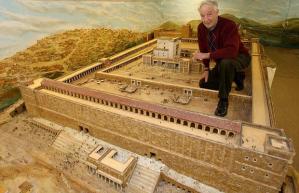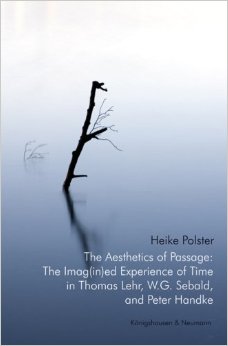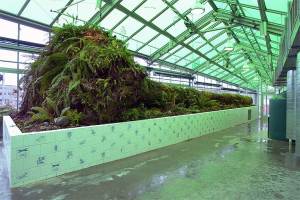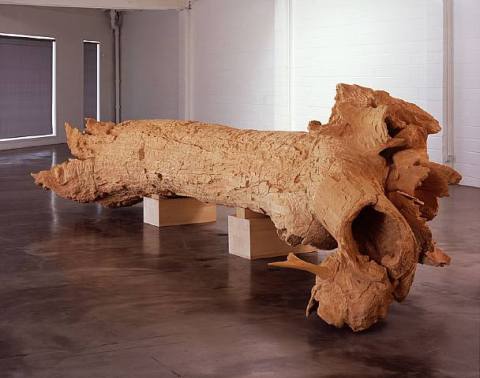“Gazing into Eternity”: Sebald & The Aesthetics of Passage
Now, as the edges of my field of vision are beginning to darken, I sometimes wonder if I will ever finish the Temple and whether all I have done so far has not been a wretched waste of time. But on other days, when the evening light streams in through the window and I allow myself to be taken in by the overall view, then I see for a moment the Temple with its antechambers and the living quarters for the priesthood, the Roman garrison, the bath-houses, the market stalls, the sacrificial altars, covered walkways and the booths of the moneylenders, the great gateways and staircases, the forecourts and outer provinces and the mountains in the background, as if everything were already completed and as if I were gazing into eternity.
This is W.G. Sebald’s narrator summarizing for the reader the statements made to the narrator by “Thomas Abrams” in The Rings of Saturn. Abrams, a pseudonym for Alec Garrard, spent some thirty years making an archeologically-correct model of the Temple of Jerusalem from 1980 until his death in 2010. To scholar Heike Polster, a professor of German at the University of Memphis, “the parallels between Abrams’ model building and Sebald’s poetics warrant a comparison.”
In her 2009 book The Aesthetics of Passage: The Imag(in)ed Experience of Time in Thomas Lehr, W.G. Sebald, and Peter Handke (Würzburg: Königshausen & Neumann), Polster “investigates how we came to image time and space in the first place, and how specific narratives and aesthetic images can probe philosophical concepts of temporality and spatiality.”
The point of this book is to map an alternative to the concept of simultaneity, one which is oriented toward Deleuzian models of the imaging of time. This innovative concept, which I call “heterochronicity,” denotes visual strategies that seek to parallelize temporally non-identical acts of visual reception…It builds on recent work in anthropology and social geography that has emphasized the evocative potential of space….Hence, this book develops a nuanced vocabulary able to determine the narrative and aesthetic strategies of images and texts which attempt to show past times, and unfolding times without changing the frame of observation.
Polster begins by investigating how “common assumptions about time and space” are found in the writings of Hegel, Kant, and Bergson. In general, Polster observes, “when we imagine time, we usually create a mental image of sorts which spatializes the relationship of a before/after situation.” After closely examining the ways in which these three philosophers construct time, she moves on to the three writers Thomas Lehr, W.G. Sebald, and Peter Handke. Somewhat oddly, in spite of not being recognized in the book’s title, there is also a substantial (and fascinating) chapter devoted to investigating the ways in which the artist Jan Peter Tripp incorporates time and heterochronicity into his paintings.
Other than a brief mention of Lehr’s novel (which I would love to read), I am going to concentrate on Polster’s approach to Sebald. Thomas Lehr’s 2005 German novel 42, which has not been translated into English, describes what might happen if time stopped on Earth – except for a small group of people who remain unaffected. As a group of seventy people finish their tour of the large particle research center in Switzerland known as CERN, the passage of time basically comes to a halt on Earth and everyone other than the seventy seems to be frozen in time and space. The plot sounds sci-fi, but the outcome is anything but. Here is Polster’s description/conclusion of what happens in a world without time.
Without time, Lehr’s horrific scenarios ultimately suspends all human value systems: in a world without constant interaction between the self and other people, human experience loses most of its meaning. Without the passage of time to generate change, development, and productive understanding, the individual is barred from any negotiation of identity, and therefore also of freedom…identity, I would argue, requires the passage of time…
In her chapter on Sebald, Polster discusses both his use of photographs and his writing, especially his writing on landscapes.
I claim that Sebald’s intention connected with his specific use of photographic images, due to the lack of supplying them with a caption, is to render them useless as documentary proof, and instead stress careful engagement with the world through an attentive gaze. This book is guided by the assumption that the prolonged gaze sustains a dialogue between the past and the present, and is a form of “heterochronic vision.” Sebald’s visual approach to landscapes creates “mnemoscapes,” heterochronic, associative, narrative spatializations that consist of memory fragments, information from literary accounts of a specific historical period, and his own visual perceptions of a particular site. Sebald’s representational practice underlines the evocative potential of space, and makes it productive for the literary project of postmemory.
In discussing Sebald’s use of photographs, Polster focuses largely, though not exclusively, on the lack of captions, which, she argues persuasively, turns these images into “an unreliable medium for memory and recollection.” Instead, these images become “reality fragments” (nice term) “that must always be interpreted, interrogated, reread….contesting the idea that past can be fixed or represented in a static image, photographic or otherwise.”
Polster notes that Sebald’s narrators are often mediating on behalf of other narrators, just as, in the quote that begins this post, the narrator of The Rings of Saturn seems to speak in the voice of Alec Garrard. For Polster, this argues that Sebald’s narratives “cannot be termed historical or documentary,” just as they are “neither memory nor history, but partake in both.” And this eventually brings us around to Polster’s thesis regarding Sebald’s relationship with time and space, her concept of “mnemoscape,” and why Alex Garrard’s odd project of reconstructing the long lost Temple of Jerusalem serves as an analogy for Sebald’s strategy of writing about histories that he has not witnessed himself. Both, she notes, “rely on information transmitted from a multitude of sources.” At one and the same time, Garrard’s model of the Temple gives an “impression of being true to life” (Sebald’s words) and yet is also what Polster calls utterly “artificial” due to its scale of 1:100.
[Sebald] develops strategies to counter a lack or loss of memories by interacting with the visible or imagined traces of the past…His imaged texts, as works of postmemory, posit the observer as the mediator between the past and the present. In place of a first-hand experience of historical events, the perception of a mnemoscape, The Rings of Saturn suggests, combines a long, uninterrupted passage through temporal phases, landscapes, discourses, and media.
This thesis was echoed more recently by several writers in the book Witnessing, Memory, Poetics: H.G. Adler & W.G. Sebald, edited by Helen Finch and Lynn L. Wolff, when they dissect and examine the strategies that Sebald, who was born in 1944, used to overcome the fact that when he wrote about World War II and the Holocaust he was addressing a history that he can scarcely claim to have experienced or born witness to.
As I like to do when I report on scholarly tomes like Polster’s, I encourage readers to get and read the book for themselves. In my very brief summary I have greatly condensed (and very possibly misconstrued) her arguments and supporting evidence. Her chapters on Lehr, Tripp, and Handke are equally deserving of attention.





